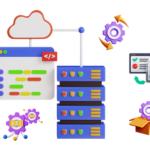Every internet access users expect real-time interactions with the web. From live updates on social media to online gaming and instant messaging, real-time communication has become a fundamental aspect of modern web applications. One powerful technology that enables real-time communication over the web is WebSockets.
These arises the question – What are Websockets? How do they work? and how does it create responsive and dynamic web applications?
WebSocket! WebSocket!! WebSockets!!!
A WebSocket is a communication protocol that provides full-duplex communication channels over a single, long-lived TCP connection. Unlike traditional HTTP requests, which are request-response-based, WebSockets enable continuous communication between a client (such as a web browser) and a server. This allows data to be sent and received in real-time, without the need to repeatedly establish a connection.
The WebSocket protocol is defined in RFC 6455 and is supported by most modern web browsers. It is particularly useful for applications that require frequent updates, such as live sports scores, stock tickers, or online multiplayer games.
How WebSockets Work
WebSockets begin with a handshake over HTTP, where the client and server agree to establish a WebSocket connection. Once the connection is established, it is “upgraded” to a WebSocket connection. This means the server and client can send and receive messages to each other at any time, with no further handshakes required.
Here’s a step-by-step breakdown of how WebSockets work:
- Initial HTTP Handshake: The client sends an HTTP request to the server, requesting to upgrade the connection to WebSocket. This is done by adding specific headers (
UpgradeandConnection) to the HTTP request. - Server Response: If the server supports WebSockets, it responds with a
101 Switching Protocolsstatus code, indicating that the connection is being upgraded to WebSocket. - Open WebSocket Connection: Once the handshake is complete, the HTTP connection is replaced by the WebSocket protocol. This allows for bidirectional communication between the client and server.
- Continuous Communication: Both the client and server can now send and receive messages freely. WebSockets provide low-latency, high-frequency data exchange, making them ideal for real-time applications.
- Closing the Connection: Either the client or the server can close the WebSocket connection when it’s no longer needed. This can be done through a special close frame sent over the WebSocket.
Key Features of WebSockets
- Full-Duplex Communication: WebSockets allow both the client and server to send and receive messages simultaneously, without waiting for the other side to respond first.
- Low Latency: WebSockets establish a persistent connection, reducing the overhead associated with repeatedly establishing new connections. This results in faster message delivery.
- Efficient Use of Resources: Since WebSockets use a single connection for all communication, they consume less bandwidth and reduce server load compared to traditional HTTP polling or long-polling methods.
- Real-Time Updates: WebSockets are ideal for applications that require real-time communication, such as chat applications, live scoreboards, financial dashboards, and multiplayer games.
WebSocket Use Cases
WebSockets are widely used in many types of real-time applications. Here are some popular use cases:
- Chat Applications: WebSockets are a natural fit for chat apps, as they allow instant message exchange between users without the delays associated with traditional polling mechanisms.
- Live Sports Scores and Events: Sports websites and apps often use WebSockets to push live scores, event updates, and notifications to users without requiring them to refresh their pages.
- Stock Market and Financial Dashboards: WebSockets enable real-time stock price updates and market data for trading platforms, allowing investors to make informed decisions instantly.
- Online Gaming: In multiplayer online games, WebSockets enable fast communication between players and the server, ensuring smooth gameplay experiences with minimal latency.
- Collaborative Applications: WebSockets are used in applications where multiple users need to work together in real-time, such as collaborative document editing, project management tools, and design platforms.
How to Implement WebSockets
To implement WebSockets, you need both a client-side and server-side component. Here’s an overview of the implementation:
Client-Side (JavaScript)
To open a WebSocket connection in the browser, you can use the WebSocket object in JavaScript.
// Create a WebSocket connection
const socket = new WebSocket('ws://yourserver.com');
// Handle connection open event
socket.addEventListener('open', (event) => {
console.log('WebSocket connection established');
socket.send('Hello, server!');
});
// Handle incoming messages
socket.addEventListener('message', (event) => {
console.log('Message from server:', event.data);
});
// Handle connection close event
socket.addEventListener('close', (event) => {
console.log('WebSocket connection closed');
});Server-Side (Node.js with ws library)
For the server side, Node.js provides a popular WebSocket library called ws to handle WebSocket connections.
const WebSocket = require('ws');
const wss = new WebSocket.Server({ port: 8080 });
wss.on('connection', (ws) => {
console.log('Client connected');
ws.on('message', (message) => {
console.log('Received message:', message);
});
// Send a message to the client
ws.send('Hello, client!');
});Conclusion
WebSockets are a powerful tool for building real-time, interactive web applications. By enabling full-duplex communication over a persistent connection, WebSockets help reduce latency, improve user experience, and make it easier to handle frequent data exchanges. Whether you’re building a chat app, financial dashboard, or online game, WebSockets provide the performance and scalability needed for dynamic, real-time communication.
As the web continues to evolve, WebSockets remain a key technology in creating responsive, engaging applications that keep users connected and informed in real time.



